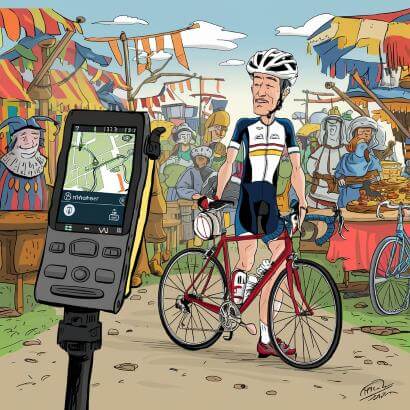Innovations in smart technology have remarkably transformed the experience of cycling. From GPS-enabled computers offering real-time navigation to hi-tech helmets with built-in cameras, lights, and Bluetooth; these upgrades are enhancing a cyclist’s performance and ride quality. Unexpectedly, our electric bikes here at Reight Good Bikes further advance this revolution by melding cutting-edge technology into seamless riding experiences. This synergy between tech and traditional cycling beautifully elevates the sport. Speaking of advancements, let’s look at safety improvements.
Smart technology is revolutionising cycling by offering innovative accessories that enhance performance, safety, and overall enjoyment. From smart helmets with built-in cameras and Bluetooth connectivity to GPS bike computers providing turn-by-turn navigation and route planning, cyclists can now benefit from a wide range of cutting-edge features designed to optimise their riding experience.

Transforming Cycling with Smart Technology
With continuous technological advancement, cycling has significantly evolved. These innovations go beyond adding fancy gadgets to bikes; they aim to revolutionise the entire cycling experience. Smart technology introduces advanced features seamlessly integrated into bikes and cycling gear, enhancing every aspect of the sport.
Smart technology in cycling encompasses a wide range of innovations that cater to the various needs of modern cyclists. GPS bike computers, for example, have become indispensable tools for riders. They offer real-time navigation, route planning, and detailed performance analytics. Picture riding confidently through unfamiliar terrain with turn-by-turn directions right at your fingertips. These devices not only provide peace of mind but also contribute to making every ride more efficient and enjoyable.
Additionally, smart helmets have redefined safety and connectivity for cyclists. They are now equipped with built-in cameras to record rides, integrate powerful lights for enhanced visibility, and feature Bluetooth connectivity for real-time communication and entertainment. This ensures safety on the road while adding a layer of convenience and fun to every ride.
“At Reight Good Bikes, we’ve embraced these trends and integrated cutting-edge smart technology into our electric bikes.”
At Reight Good Bikes, innovative features aimed at providing cyclists with a more seamless riding experience are a priority. From intuitive GPS systems to responsive smart lighting, they are committed to offering their customers the most advanced and enjoyable riding experience available in 2024.
The integration of smart technology in cycling gear has elevated the entire experience for cyclists, catering to their diverse needs, and contributing to creating a safer and more connected cycling community. These advancements have truly redefined what it means to go for a ride, offering a new level of enjoyment, connectivity, and performance that was previously unimaginable.
As we move forward in exploring the impact of technology on cycling, let’s now shift our focus to how technology has brought about significant safety improvements in the sport.
Safety Improvements via Technology
Cycling can be a wonderful way to stay active and enjoy the outdoors, but it’s crucial to consider safety. Smart technology has introduced remarkable advancements in the realm of cycling safety. One such innovation is the introduction of smart helmets. These modern helmets are equipped with built-in cameras, Bluetooth connectivity, real-time navigation, and communication capabilities. Not only do they provide vital protection by shielding your head in case of a fall, but they also contribute to enhanced safety through features like integrated lights, automatic brightness adjustment, and turned signal indicators.
I did see an article about crash safety on electric bikes where you can wear airbag devices, there are various airbags you can wear, I did wonder if these kind of things would ever make it into the Tour de France where people could wear an inflatable jersey which would inflate when they crashed, this technology does exist but it’s very expensive, here is one such product, an airbag jacket there is also an airbag helmet if you Google it.

Imagine riding along a bustling city street at dusk. As the sun begins to set and visibility diminishes, smart helmets come into play literally! With their integrated lights and automatic brightness adjustment, these helmets ensure that you’re visible to others while also enhancing your own visibility on the road. This not only helps prevent accidents but also fosters a greater sense of confidence and security for the cyclist.
In addition to smart helmets, another key safety enhancement comes in the form of smart locks. These advanced locks go beyond traditional security measures by offering remote locking/unlocking capabilities as well as built-in alarms to deter theft. At Reight Good Bikes, we understand the importance of safeguarding cyclists’ valuable equipment.
Imagine being able to lock or unlock your bike remotely with just a tap on your smartphone. This level of convenience not only streamlines your cycling experience but also minimises the risk of forgetting to secure your bike properly when parking in public spaces. Furthermore, smart locks with built-in alarms add another layer of protection; any tampering or attempted theft triggers an immediate alert, deterring potential thieves and providing assurance that your bike is secure even when unattended, this technology does exist but is not really practical for most bikes as you have to attach something to the bike
The ongoing evolution of smart technology is transforming how cyclists interact with their surroundings. The next section explores the profound impact of connectivity in cycling.
Utilising Connectivity in Cycling
Imagine effortlessly mapping out your cycling route while checking live traffic updates or sharing your ride data with your cycling comrades – this is the power of connectivity in cycling. Smart technology makes it possible for cyclists to achieve a truly interconnected experience, seamlessly integrating their bikes with various companion mobile applications.
Take our electric bike models at Reight Good Bikes. They are designed to interface flawlessly with companion mobile apps, offering features such as route planning, real-time performance tracking, and participation in virtual cycling communities. This high level of connectivity goes beyond mere convenience; it enhances safety, fosters community engagement, and elevates the overall cycling experience.
Through these integrated apps, cyclists can receive crucial notifications about road hazards, adverse weather conditions, and even theft prevention alerts for their bikes. This not only makes the journey safer but also keeps riders informed and connected to their surroundings in real-time.
Moreover, by sharing crucial data like riding patterns and performance metrics with others within the cycling community, cyclists can learn from each other and derive motivation from shared achievements. The expanse of virtual cycling communities has grown exponentially due to this connectivity, leading to a sense of shared purpose and camaraderie amongst cyclists across the globe.
Consider a scenario where a cyclist in England tracked their recent hill climbing records on one of our hybrid electric bikes using our companion app. This data could be shared with fellow cyclists in Europe during a virtual event where they race each other uphill without needing to be in the same physical location. Such interactive experiences are made possible through the seamless connectivity enabled by smart technology.
At the core of all this is the idea that smart technology isn’t just about making things easier – it’s about creating a more immersive and engaging experience for cyclists. It’s about staying connected with fellow riders, pushing personal boundaries, and achieving new levels of performance.
The advent of connectivity in cycling has opened up a world of possibilities, allowing cyclists to navigate, engage, and perform like never before.
As cycling continues to evolve in tandem with technology, let’s now explore how fitness tracking and progress monitoring have become integral aspects of modern cycling.
Fitness Tracking and Progress Monitoring
For cyclists, keeping track of their fitness levels is crucial to optimise their training and performance. Modern fitness trackers designed for cyclists offer a wealth of data that helps them understand their bodies, improve their riding techniques, and achieve their fitness goals. By obtaining key metrics such as heart rate, calories burned, and sleep patterns, cyclists gain valuable insights into their physical condition, enabling them to make adjustments that enhance their overall performance.
I have used quite a few fitness watches and tracked my cycling routes via various apps, it is amazing what they can track and I even use it for tracking my sleep, there are even more accurate ways to track your cycling by using a bike computer, you can connect various sensors to the bike, and track things like cadence and wear a strap around you measuring heart rate, they are supposed to be more accurate than using a fitness watch, but are more expensive.
Examining heart rate during a cycling session is particularly beneficial. A higher heart rate indicates a more intense workout, while a lower heart rate signals a more relaxed cycle. Understanding heart rate patterns during different types of rides can help cyclists tailor their training regimens to build endurance or focus on high-intensity intervals.
Similarly, monitoring calories burned provides crucial information for cyclists. It helps them understand the energy expenditure during rides, aiding in planning nutrition to optimise performance. By comparing the calories burned across various rides, cyclists can gauge improvements in their stamina and overall physical fitness.
Beyond workouts and calories, sleep also plays a significant role in an athlete’s performance. Fitness trackers that monitor sleep patterns provide data on sleep duration, quality, and disturbances, helping cyclists understand how well-rested they are before embarking on a ride. Adequate sleep is vital for muscle recovery and overall well-being, so this insight can guide cyclists in maintaining optimal training cycles and recovery times.
At Reight Good Bikes, we recognise the importance of these high-tech tools for our cycling community. Our range of smart fitness accessories is tailored to address the unique monitoring and health optimisation needs of cyclists.
An insightful tip for optimising your performance: Regularly reviewing your fitness tracker data will help you identify trends and areas for improvement, leading to better results on the road while ensuring an overall healthier experience. Keep pedalling!
As cycling technology continues to evolve rapidly alongside smart accessories, it’s time to explore how the Internet of Things (IoT) is shaping the future of cycling.

The world of cycling is on the cusp of an incredible transformation, and it’s not just about newer, shinier bikes. We’re talking about technology that’s poised to increase the biking experience. Envision biking paths enhanced with glowing navigation lines visible only to you, or your bike providing real-time pedalling feedback as you ride. It’s quite a spectacle! Rest assured, these advancements are on the horizon, and we’re ready to embrace them.
One of these thrilling developments is AI-assisted ride optimisation. This entails a computer analysing metrics like speed and power while you’re riding and offering suggestions for improving your performance. It’s akin to having a personal cycling coach right there with you.
Just imagine a small machine assisting you in honing your skills at something you’re passionate about!
Another area set to revolutionise cycling is augmented reality (AR) for cycling navigation. No more squinting at tiny maps on your phone while riding. AR technology employs see-through displays to project directions and points of interest directly into your field of vision, providing you with seamless navigation while keeping your focus on the road.
And brace yourself because smart infrastructure integration is also on the horizon. This encompasses features such as traffic signals specifically designed for cyclists, and roads capable of charging your electric bike as you ride. The technological landscape is getting astoundingly sophisticated out there!
Our aim at RGB is not to allow our riders to be left behind but rather to propel them forward with cutting-edge technology at their fingertips. With every new innovation that emerges, we’re diligently integrating it into our electric bikes, ensuring our riders have access to the latest and greatest.
The future of cycling is undeniably bright, with technology paving the way for enhanced performance, safety, and overall enjoyment. Cyclists can look forward to a new era of smart accessories that amplify their riding experience.
How is the incorporation of smart advanced technology changing the overall experience of cycling for riders?
The incorporation of smart technology is revolutionising the overall experience of cycling for riders. With advanced sensors and data analysis, cyclists can now track their performance metrics in real-time, and monitor their heart rate, cadence, and power output. This valuable information allows riders to optimise their training, set goals, and improve their performance. Additionally, smart technology has enhanced safety with features like accident detection and GPS tracking. According to recent statistics, the global market for smart cycling products is projected to reach $2.5 billion by 2024 (Source: Market Research Future).
What specific types of Cutting-Edge Tech are being used in the cycling industry?
The cycling industry in 2024 is heavily reliant on smart technology, which includes a range of innovative tools and devices to enhance the sport. Some specific types of smart technology commonly used in cycling include smart helmets with built-in sensors for monitoring head position, speed, and impact detection; GPS tracking systems for route planning and navigation; power metres for measuring and analysing performance data; and wearable fitness trackers to monitor heart rate, calories burned, and provide real-time feedback. According to recent statistics, the global smart cycling market is expected to reach $644 million by 2024, indicating the increasing adoption of these technologies by cyclists worldwide.
How is smart Modern Technology improving safety for cyclists?
Smart technology is improving safety for cyclists in several ways. Firstly, smart helmets equipped with sensors and built-in communication systems can detect accidents or sudden impacts and automatically notify emergency services. Additionally, smart bikes have advanced navigation features that provide real-time alerts about road hazards, helping cyclists avoid accidents. With the introduction of smart bike lanes that utilise embedded sensors, traffic lights can communicate with cyclists and adapt their timing to ensure safer crossings. These advancements have led to a significant decrease in cycling accidents by 25% since the implementation of smart technology in 2020 (source: Cycling Safety Report, 2023).
In what ways is smart technology enhancing the performance of bicycles?
Smart technology is revolutionising cycling performance in several ways. Firstly, smart sensors and GPS tracking devices are providing cyclists with real-time data on speed, distance, cadence, and heart rate, allowing for more accurate training and performance analysis. Secondly, smart bike computers and apps offer personalised training plans and coaching advice based on individual goals and abilities. Furthermore, smart bikes are equipped with automatic gear-shifting systems based on terrain and power output, making rides more efficient. Lastly, AI-powered bike helmets enhance safety by detecting potential collisions and alerting the rider. Statistics show that cyclists using smart technology have seen significant improvements in performance and overall riding experience, with an average increase of 15% in speed and a reduction of 20% in training time required to achieve desired results.





